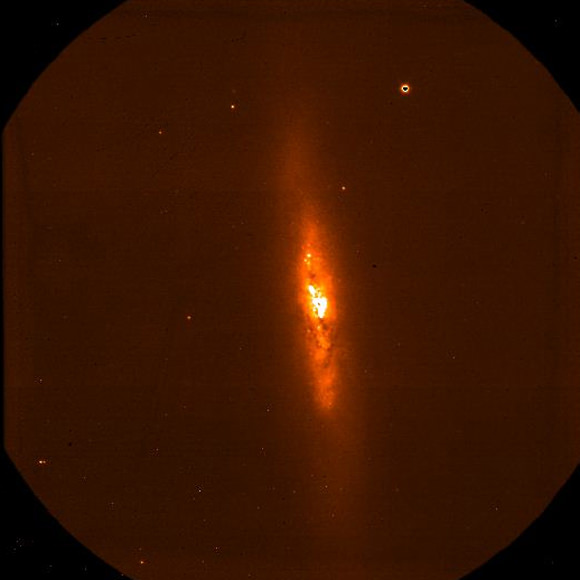The MOSFIRE instrument had been under construction at UCLA during my time there and several of my friends worked on it. It is good to see their efforts paid off and the instrument is online and will soon be taking data.
Here's one of the unprocessed images it took on April 4:
 |
| The Antennae Galaxies. Credit: W. M. Keck Observatory |
MOSFIRE is pretty neat as it's a combination of a multi-object spectrograph and an imager. It has 46 sliding bars that can be independently moved to cover up the image and form slits. These slits can thus target 46 independent targets simultaneously. The light from the slits is passed through the spectrometer which spreads it according to wavelength and gives you the spectrum of an object. Spectra are immensely useful in astronomy as they tell us about the properties of the material emitting the light, such as the composition, density, radial velocity, rotational velocity, and more.
Since the slits can be opened or closed at will, you can choose to have them all open providing you with a 6.1 arcminute field of view (the full Moon is about 30 arcminutes across). This allows you to image a fairly large part of the sky and then switch over to spectroscopy on any targets you find interesting. The images thus far being shown were taken through the imaging mode.
 |
| M82 as seen by MOSFIRE. Credit: W. M. Keck Observatory |
MOSFIRE observes at near-infrared wavelengths (0.97-2.45 microns). Human eyes can see out to about 0.6 microns (red) so this is beyond human vision. The advantage of the near-infrared is that you can penetrate dust clouds that obscure optical, or visible, light (but not infrared) or can study objects that are very cool in temperature. The colder the object, the longer the wavelength at which most of the emission comes out. Brown dwarfs, such as those WISE can detect, can be cool enough to make them difficult to detect in optical light. Physically, these are objects that are not massive enough to have hydrogen fusion in their cores, which is the defining characteristic of a star. These brown dwarfs can range in mass from about 13 to 80 times the mass of Jupiter and are not much larger than Jupiter in size. Astronomers love to study them as they are the boundary between low-mass stars and giant planets.
Here's a video Greg Mace of UCLA made of the team installing MOSFIRE on Keck I:
No comments:
Post a Comment
Note: Only a member of this blog may post a comment.